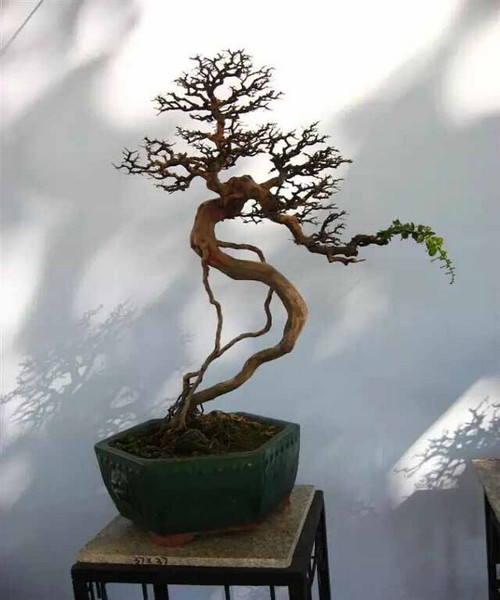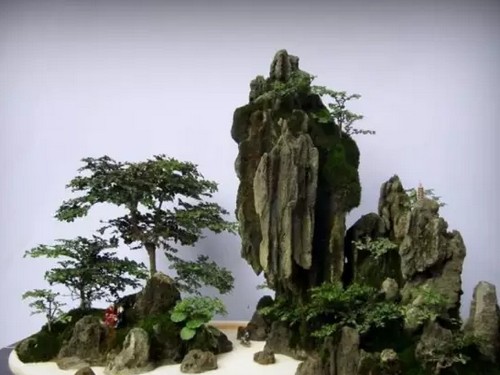Sichuan style bonsai reflects the elegant urban temperament of Chengdu.
Bonsai is a bright spot in Chengdu's gardens and museums. As a characteristic intangible cultural heritage of Chengdu, Sichuan style bonsai is one of the four major schools of Chinese traditional bonsai. From the Eastern Han Dynasty, bonsai artists in Shu began to explore how to condense the wonders of landscape and nature into a small basin. To the five dynasties, the bonsai art in Shuzhong was in the ascendant and established a school of its own. Sichuan bonsai began in the Tang and Song dynasties, formed in the Ming and Qing dynasties, and finally formed a unique Sichuan bonsai production skills and style. Sichuan bonsai is famous for its "advanced art and beautification of nature", which reflects that Chengdu has always been a city of leisure and wealth and elegant style.

Look at the non-heritage
The bonsai of Sichuan School is inseparable from the infiltration of the natural and cultural environment of Bashan Shu River.
Sichuan bonsai has always been known as "three-dimensional painting" and "silent poetry". Yesterday, the reporter saw in the people's Park that the carefully trimmed bonsai was lush, exquisite, exquisite and harmonious. They seem to condense the beautiful scenery of Bashan Shu River, making the audience linger. "Sichuan bonsai is not only exquisite and beautiful, but also has great knowledge." Yesterday, Zhang Zhongmin, the inheritor of Chengdu bonsai production skills, explained the mysteries of Sichuan bonsai to reporters. Pointing to the bonsai around him, he told the reporter with interest that because Sichuan is extremely rich in landscapes and trees, and the geomorphological environment faces mountains and dangerous waters, Sichuan sent bonsai to assemble you, Xiu, dangerous, Xiong, high, hanging, steep, and deep shapes in a bowl. Bonsai trees are ancient, drooping, inverted hanging pattern condensed into a scene.
He explained to the reporter that after generations of bonsai artists' exploration and practice, Sichuan sent bonsai in the production techniques to form a unique style and techniques. Production techniques are divided into tree stump bonsai production skills, mountain and stone bonsai production techniques, tree and stone combination bonsai production techniques. The first kind is good at showing the various posture of trees, which has excellent aesthetic value and ornamental effect; the second kind is good at expressing strange mountains and rocks and the magical creation of nature, which is refreshing; the third kind is a combination of the first two skills, comprehensively showing the secluded beauty of trees and landscapes, reflecting a harmonious and highly condensed aesthetic. No matter how varied the production techniques and means of expression of Sichuan bonsai are, its core can not be separated from the infiltration and edification of the natural and cultural environment of Bashan Shushui. He said proudly that the most essential artistic feature of Sichuan bonsai is to "see the whole through a small part and shrink the dragon into an inch." In the 1960s, Marshal Chen Yi gladly wrote an inscription after a taste of Sichuan bonsai: "Advanced art, beautify nature." Although the language is insipid, it expresses a Sichuan people's love for Sichuan school bonsai.
Sichuan bonsai should be molded with emphasis on artistic conception and fine selection of materials for at least 3 to 5 years or 10 years.
"the production of these bonsai ranges from 3-5 years to more than 10 years, or even longer." Looking at the reporter's surprised expression, Zhang Zhongmin said that Sichuan sent bonsai to Chengdu as the center, representing the bonsai art style of Sichuan Province. In the traditional bonsai production methods, there are five methods of branch modeling, such as cutting, bending, flat binding, grafting and carving, as well as auxiliary methods such as branch and leaf and root modeling. In the process of plastic surgery and pruning, it is often emphasized to look, slow and cut, and be implemented step by step. He said that the Sichuan style tree stump bonsai is famous for its rich and colorful regular traditional banding skills, with a variety of names and a certain rhythm. the trunk and side branches are bent according to different formats from an early age, paying attention to three-dimensional spatial composition. The stem forms are crutches, square crutches, opposite crutches, rolling dragon pillars, three bends and nine inverted turns, big bends and drooping branches, and so on. The methods of flat branches are flat branches, rolling branches, half-flat and half-turning, and so on. On the other hand, the roots of trees are mainly in the shape of intertwined roots and exposed claws. The tree species used are golden marbles, pedicel begonia, Luo Han Song, June snow, plum, pomegranate, bamboo and so on. In recent decades, on the basis of inheriting the traditional modeling, Sichuan style bonsai has innovated a number of natural bonsai with natural posture and characteristics, which are interesting in contrast with the traditional quaint pile scenery, creating a new way for the development of Sichuan school tree stump bonsai.
How can we create a good work? He says that the first is the idea that when making bonsai, such as painting, you should focus on the pen and look at the artistic conception; the other is to select materials, whether it is stone or tree, to integrate with the artistic conception of creation; and finally, the layout should be reasonable, with a clear distinction between primary and secondary, sparse and sparse. In order to become a generation of famous bonsai makers, bonsai production skills are of course important, and the traditional culture is also important. Zhang Zhongmin has been engaged in bonsai art creation, landscape design, construction and production management since 1978. Study the relationship between the plane and facade space of landscape architecture and bonsai production, and worship bonsai art master Chen Sifu, bonsai artists he Ziyuan and Chen Guqing as teachers. Learn from them comprehensively and systematically the techniques of planting stumps, landscape bonsai production, gardening, mountain stacking, water management, greening and planting. At the same time, he also studied Chinese landscape painting from famous landscape painters Zhang Youjing, Zhu Changdi and Luo Qixin, and at the same time studied Chinese flower-and-bird painting and calligraphy, making its bonsai full of Chinese landscape painting artistic conception.
Product history
The bonsai of Sichuan School has a long history and has been sung by literati of all ages.
The bonsai art of Sichuan School continues from the Eastern Han Dynasty to the present. It is understood that an Eastern Han tomb was unearthed in Chengdu in 1979, and a strip clay basin was unearthed, equipped with wood-carved lotus bonsai, which is the earliest material evidence about bonsai in Chengdu. It is said that during the five dynasties, an official surnamed Mei lived in seclusion in the western suburbs of Chengdu under the account of Meng Zhixiang, who planted plum trees everywhere and made various postures according to the pictures. in the Tang Dynasty, the Sichuan school bonsai has a certain development, in some religious themes of stone carvings, grottoes, can be witnessed To the Song Dynasty, some poets such as Su Dongpo, Lu you and Mei Yaochen enjoyed and made some mountain and stone bonsai in the courtyard, hall, and in their poems. For example, Su Kui once wrote the Story of wooden rockery to express his feelings through the scenery. After Su Dongpo also wrote "double Stone Poems". During his stay in Shu, the patriotic poet Lu you also wrote many poems about bonsai, and at the same time he also made bonsai himself. By the Yuan, Ming and Qing dynasties, the bonsai techniques of Sichuan School had made great progress. Most importantly, Panzha techniques rose and developed among folk florists, which contributed to the prosperity of Sichuan bonsai stumps and the rapid development of techniques.
At the end of the Qing Dynasty and the beginning of the Republic of China, a flower party was held at the Chengdu Qingyang Palace in 25 of the first lunar month every year, and florists and potters all sent their stumps to the flower show for display, sale and evaluation. The treasure jade tree stump bonsai, which is now hidden in the Palace Museum in Beijing, Chu Xiu Palace and Yangxin Zhai, is basically the same as the regular stump in Chengdu. These tree stumps and bonsai were birthday gifts given to the emperor by Sichuan officials at that time, and the trunk and branch plates displayed were unique to the Sichuan School. According to the evaluation of industry experts, if it were not for food and clothing, people would never have leisure and elegance to play with bonsai; without profound cultural heritage, Sichuan bonsai would not have become one of the four major schools of bonsai in the country. The development history of Sichuan bonsai reflects that Chengdu has always been a rich and elegant city.
Time: 2019-06-04 Click:
- Prev

Bonsai in Flower Village of Lingnan-- on the Origin and Development of Bonsai Art in Fangcun
Fangcun Flower Land is the birthplace of Lingnan bonsai. Huadi, formerly known as Huachi, is located on the banks of Baie Pool on the Pearl River in Guangzhou. It has a history of planting flowers for nearly 2000 years. At the end of the Qing Dynasty, Kang Youwei built villas and houses in the garden of the flower land, and wrote a large number of poems here.
- Next

Historical Origin of Sichuan Style Bonsai Art
Sichuan suitable climate, dense vegetation, rich products, outstanding people, since ancient times has the reputation of the land of abundance, with the conditions for the development of bonsai. Sichuan bonsai is named after the region of the bonsai art school, it originated from the Five Dynasties, has a long history. Sichuan bonsai is roughly divided into two artistic styles: western Sichuan and eastern Sichuan
Related
- Fuxing push coffee new agricultural production and marketing class: lack of small-scale processing plants
- Jujube rice field leisure farm deep ploughing Yilan for five years to create a space for organic food and play
- Nongyu Farm-A trial of organic papaya for brave women with advanced technology
- Four points for attention in the prevention and control of diseases and insect pests of edible fungi
- How to add nutrient solution to Edible Fungi
- Is there any good way to control edible fungus mites?
- Open Inoculation Technology of Edible Fungi
- Is there any clever way to use fertilizer for edible fungus in winter?
- What agents are used to kill the pathogens of edible fungi in the mushroom shed?
- Rapid drying of Edible Fungi

